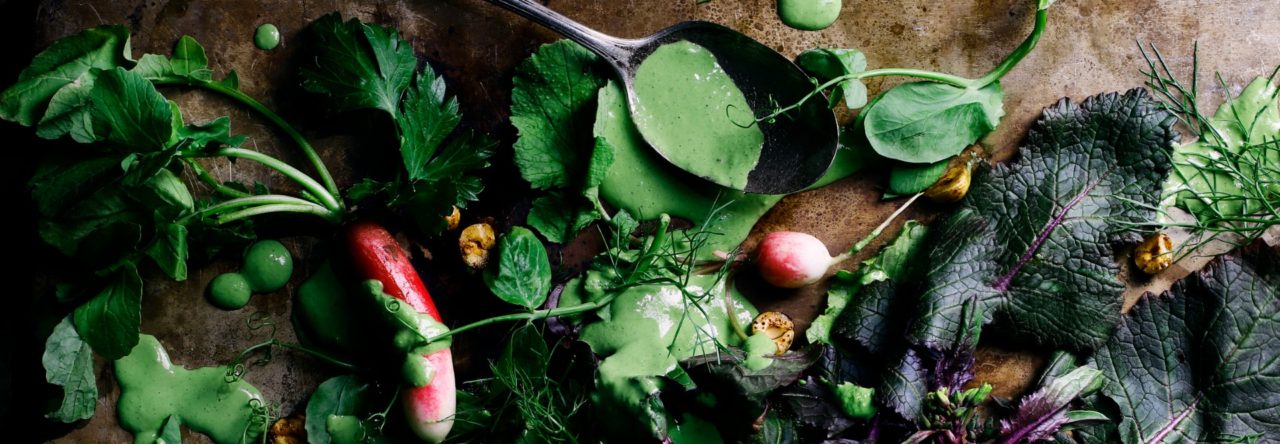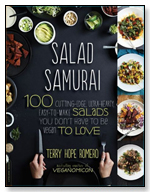Recipe Index
Okonomiyaki, Japanese “pizza”
makes four 7″ diameter pancakes
This was originally published in my column in VegNews and I have no idea how many people have made this, other than I love it. Please try it for yourself and let me know!
Okonomiyaki, sometimes referred to as Japanese “pizza”, is a comforting street food that takes well to leftover veggies, veggie proteins and even the occasional soba noodle. The secret to it’s gluey batter is the root veggie nagaimo, sometimes called “mountain potato”, a mild-flavored Japanese tuber that gets crazy gooey as you shred it; look for it in Japanese or Korean markets. If it’s impossible to find use regular white peeled potato for now.
TIP: A large, seasoned cast iron skillet is an excellent choice for frying up okonomiyaki, but whatever you use make sure it’s cooking surface is well oiled. The traditional way to flip okonomiyaki works beautifully: use two wide spatulas, slide under opposite sides and flip the entire pancake over in one swift motion.
Batter:
3 1/2 inch chunk nagaimo root or white potato, peeled
1 tablespoon shoyu or any soy sauce
1 1/2 cups water
3/4 cup all purpose flour
1 tablespoon pickled ginger, finely chopped
1/2 lb napa cabbage, sliced into thin shreds
4 scallions, trimmed and thinly sliced
1/2 cup tenkasu (packaged tempura flakes) or panko crumbs
Cooked-in toppings: choose two or more, about 2 tablespoons per pancake:
abu-ragi, prepared fried tofu pouches, sliced into strips
shredded carrot
any purchased Japanese pickle, sliced
unsweetened mochi cake, grated
vegan ham, chicken or seafood, sliced into matchsticks
cooked green peas, edamame or corn
cooked cold soba noodles
cooked sliced shitake or raw whole enoki mushrooms
Garnish: use all on pancakes:
1 recipe Tonkatsu Sauce
1/3 cup vegan mayonnaise, beaten until smooth
1-2 tablespoons aonori (green powdered seaweed)
1-2 tablespoons toasted sesame seeds
1 nori sheet, toasted, cut into thin strips
1. Using a fine-toothed grater, grate fresh nagaimo directly into large mixing bowl. Unwrap only enough nagaimo for recipe, holding onto wrapped end while shredding; it will get intensely slimy the more it’s grated so don’t worry, keep on grating. If you have any remaining nagaimo you want to use for another batch of okonomiyaki later, just let the root sit unwrapped on the kitchen counter until the cut end dries, then wrap in plastic wrap and store in the veggie bin. If you’re using plain white potato just grate it up and proceed ahead.
2. Add soy sauce, water and flour to the grated nagaimo and mix to form a viscous batter; small lumps are okay. Stir in pickled ginger, cabbage and scallions and fold to coat everything with batter. Set aside for 30 minutes while preparing tonkatsu sauce and slicing and getting ready the cooked-in toppings and the garnish toppings. Right before cooking fold tempura flakes or panko crumbs into batter.
3. Heat a large cast iron skillet over medium heat; it’s ready to use when a drop of water sizzles on contact with pan. Spray generously with cooking spray, then scoop 1 overflowing cup of batter into pan; spread pancake batter with bottom of measuring cup to about 1 inch thickness. Press cooked-in topping onto surface of pancake. Cook for 6 to 8 minutes or until pancake top looks semi-dry and underneath is golden. Use a large, wide spatula to carefully flip the pancake and cook another 5 minutes on opposite side. Now flip one more time and generously brush top of the okonomiyaki with tonkatsu sauce, spreading sauce to edges.
4. Gently slide the pancake to a serving dish, sauce side facing up. Drizzle sparingly with mayonnaise (a squeeze condiment bottle is perfect), sprinkle with aonori powder, then sesame seeds and finally arrange a few nori strips on top. Serve hot okonomiyaki immediately.








